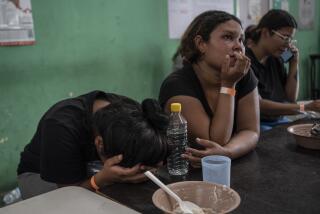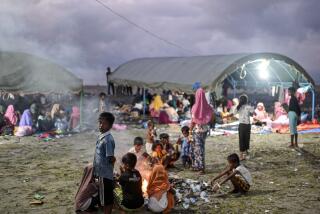Desert or sea: Coronavirus traps migrants in mid-route danger zone

- Share via
Thousands of desperate migrants are trapped in limbo and at risk of death without food, water or shelter in scorching deserts and at sea, as governments close borders and ports in the face of the coronavirus outbreak.
Migrants have been dropped by the truckload in the Sahara or bused to Mexico’s border with Guatemala and beyond. Others are drifting in the Mediterranean after European and Libyan authorities declared their ports unsafe. And about 100 Rohingya refugees from Myanmar are believed to have died in the Bay of Bengal, as country after country pushed them back out to sea.
Many governments say that a public health crisis requires extraordinary measures. However, these measures are just the latest steps taken to clamp down on migrants.
“They just dumped us,” said Fanny Jacqueline Ortiz, a 37-year-old Honduran who was abandoned March 26 with her two young daughters at the lonely El Ceibo border crossing between Mexico and Guatemala, expelled first by the U.S. and then by Mexico.
Since the aftermath of World War II, international and some national laws have protected refugees and asylum seekers. Nations have the right to close themselves off for national security but cannot forcibly return migrants to danger, said Violeta Moreno-Lax, professor of migration law at Queen Mary University of London.
Yet that is exactly what is happening.
“The pandemic provides the perfect excuse,” Moreno-Lax said.
The desert deportations have been happening for years in North Africa and beyond, and Europe has been deadlocked on how to handle migration on the Mediterranean since the 2015 migration crisis. In the United States, President Trump made immigration a central issue of his winning 2016 campaign.
But this year, the coronavirus outbreak has shifted the dynamic and allowed governments to crack down even harder, even as the desperation of those on the move remains unchanged.
Trump is using a 1944 public health law to set aside decades-old U.S. immigration law. Nearly 10,000 Mexicans and Central Americans were “expelled” to Mexico less than three weeks after the new rules took effect March 21, according to U.S. Customs and Border Protection. U.S. authorities say the decision was not about immigration but about public health.
Mexico then pushes the migrants farther south. Mexico denies that it leaves migrants to fend for themselves, saying it coordinates with their home governments.
Migrants have also been left stranded in similarly makeshift conditions in the Sahara after being expelled from Algeria and Libya.
Groups of dozens are walking six to 10 miles through the desert from a no man’s land called Point Zero to the dusty frontier village of Assamaka in neighboring Niger. There, new arrivals remain in makeshift quarantine for 14 days.
More than 2,300 foreign migrants are stranded in Niger, unable to return home or go anywhere else, according to the United Nations’ International Organization for Migration.
In Libya, the migrant detention center in Kufra expelled nearly 900 men and women from April 11 to April 15, taking them by truck or bus across hundreds of miles of sand and leaving them either in a remote town in Chad or at a Sahara border post in Sudan, said Lt. Mohamed Ali Fadil, the center’s director. Hundreds more came the following week.
Fadil said the center is “deporting more people faster than ever before.” He said the expulsions are an attempt to shield migrants from the coronavirus.
Yet the large groups of migrants forced out are in danger not only of the coronavirus but of midday temperatures that can rise to 120 degrees this time of year.
Hundreds of other migrants are stuck at sea in the Mediterranean and the Bay of Bengal.
The Mediterranean has been unpatrolled by rescue boats for two weeks. The last two such vessels are lashed together off the coast of Italy along with a ferry holding 180 migrants rescued in April, all of them in a 14-day waterborne quarantine.
The boats will ultimately dock. But no country has agreed to take in the migrants, who will stay on the ferry until their fate is decided. Any others who try to leave Libya’s squalid coastal detention centers or cramped smugglers’ warehouses will face an equally uncertain future, either pushed back to Libya or adrift at sea.
Half a world away, hundreds of Rohingya refugees are stranded at sea in the Bay of Bengal. Weeks ago, they boarded at least two fishing trawlers, and they are now marooned off the coast of Bangladesh.
Fishermen spotted the boats April 20, and the U.N. refugee agency said they may have been at sea for weeks without enough food and water. A group of 29 made it to an island in southern Bangladesh on Saturday. The aid group Doctors Without Borders said survivors on another boat that ultimately made it to shore estimated that about 100 had died waiting.
The Bangladeshi government said it cannot sustain more refugees and still keep a handle on the coronavirus crisis. Malaysia has also denied entry to several other boats, each with dozens on board.
In her tiny bamboo home in the Rohingya refugee camp at Cox’s Bazar in Bangladesh, Rahima Khatun has been sleepless since losing contact with her daughter, who went to sea with her grandchildren more than 50 days ago to join her son-in-law in Malaysia.
Khatun is not sure which boat they are on but she has heard about the stranded trawlers.
“If I had wings I would fly and go see where they are,” Khatun said. “They are not being allowed to enter either Bangladesh or Malaysia — just floating in the middle with no one to help them out.”
More to Read
Sign up for Essential California
The most important California stories and recommendations in your inbox every morning.
You may occasionally receive promotional content from the Los Angeles Times.










